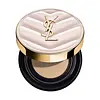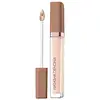What's inside
What's inside
 Key Ingredients
Key Ingredients

 Benefits
Benefits

 Concerns
Concerns

 Ingredients Side-by-side
Ingredients Side-by-side

Water
Skin ConditioningMethyl Trimethicone
Skin ConditioningDimethicone
EmollientEthylhexyl Methoxycinnamate
UV AbsorberTitanium Dioxide
Cosmetic ColorantEthylhexyl Salicylate
UV AbsorberDiphenylsiloxy Phenyl Trimethicone
Skin ConditioningButylene Glycol Dicaprylate/Dicaprate
EmollientLauryl PEG-9 Polydimethylsiloxyethyl Dimethicone
Skin ConditioningGlycerin
HumectantPentylene Glycol
Skin ConditioningButylene Glycol
HumectantTrisiloxane
Skin ConditioningPEG-10 Dimethicone
Skin ConditioningMagnesium Sulfate
Acrylates/Stearyl Acrylate/Dimethicone Methacrylate Copolymer
Phenoxyethanol
PreservativeDimethicone Crosspolymer
Emulsion StabilisingDisteardimonium Hectorite
StabilisingLauroyl Lysine
Skin ConditioningEthylhexylglycerin
Skin ConditioningStearic Acid
CleansingPolyhydroxystearic Acid
EmulsifyingAlumina
AbrasiveTriethoxycaprylylsilane
Calophyllum Inophyllum Seed Oil
AntimicrobialIsododecane
EmollientLecithin
EmollientIsopropyl Myristate
EmollientIsostearic Acid
CleansingEthylhexyl Palmitate
EmollientAdenosine
Skin ConditioningPolyglyceryl-3 Polyricinoleate
EmulsifyingDisodium EDTA
Silica Silylate
EmollientBHT
AntioxidantPropylene Carbonate
SolventTocopherol
AntioxidantJasminum Sambac Flower Extract
MaskingParfum
MaskingWater, Methyl Trimethicone, Dimethicone, Ethylhexyl Methoxycinnamate, Titanium Dioxide, Ethylhexyl Salicylate, Diphenylsiloxy Phenyl Trimethicone, Butylene Glycol Dicaprylate/Dicaprate, Lauryl PEG-9 Polydimethylsiloxyethyl Dimethicone, Glycerin, Pentylene Glycol, Butylene Glycol, Trisiloxane, PEG-10 Dimethicone, Magnesium Sulfate, Acrylates/Stearyl Acrylate/Dimethicone Methacrylate Copolymer, Phenoxyethanol, Dimethicone Crosspolymer, Disteardimonium Hectorite, Lauroyl Lysine, Ethylhexylglycerin, Stearic Acid, Polyhydroxystearic Acid, Alumina, Triethoxycaprylylsilane, Calophyllum Inophyllum Seed Oil, Isododecane, Lecithin, Isopropyl Myristate, Isostearic Acid, Ethylhexyl Palmitate, Adenosine, Polyglyceryl-3 Polyricinoleate, Disodium EDTA, Silica Silylate, BHT, Propylene Carbonate, Tocopherol, Jasminum Sambac Flower Extract, Parfum
Water
Skin ConditioningCI 77891
Cosmetic ColorantBis-Stearyl Dimethicone
EmollientCaprylyl Methicone
Skin ConditioningIsohexadecane
EmollientCetyl PEG/PPG-10/1 Dimethicone
EmulsifyingGlycerin
HumectantIsononyl Isononanoate
EmollientDiphenyl Dimethicone
EmollientPolyglyceryl-4 Isostearate
EmulsifyingTrimethylsiloxysilicate
EmollientC30-45 Alkyl Dimethicone
Skin ConditioningStearyl Dimethicone
EmollientCI 77492
Cosmetic ColorantAlumina
AbrasiveButylene Glycol
HumectantBoron Nitride
AbsorbentSodium Potassium Aluminum Silicate
Phenoxyethanol
PreservativeSodium Chloride
MaskingDisteardimonium Hectorite
StabilisingCI 77491
Cosmetic ColorantPotassium Sorbate
PreservativeSodium Dehydroacetate
PreservativeCaprylic/Capric Triglyceride
MaskingTriethoxycaprylylsilane
Tocopheryl Acetate
AntioxidantSilica Dimethyl Silylate
EmollientC20-24 Olefin
Skin ConditioningSilica
AbrasivePropylene Carbonate
SolventCI 77499
Cosmetic ColorantParfum
MaskingVitis Vinifera
MaskingWater, CI 77891, Bis-Stearyl Dimethicone, Caprylyl Methicone, Isohexadecane, Cetyl PEG/PPG-10/1 Dimethicone, Glycerin, Isononyl Isononanoate, Diphenyl Dimethicone, Polyglyceryl-4 Isostearate, Trimethylsiloxysilicate, C30-45 Alkyl Dimethicone, Stearyl Dimethicone, CI 77492, Alumina, Butylene Glycol, Boron Nitride, Sodium Potassium Aluminum Silicate, Phenoxyethanol, Sodium Chloride, Disteardimonium Hectorite, CI 77491, Potassium Sorbate, Sodium Dehydroacetate, Caprylic/Capric Triglyceride, Triethoxycaprylylsilane, Tocopheryl Acetate, Silica Dimethyl Silylate, C20-24 Olefin, Silica, Propylene Carbonate, CI 77499, Parfum, Vitis Vinifera
 Reviews
Reviews

Ingredients Explained
These ingredients are found in both products.
Ingredients higher up in an ingredient list are typically present in a larger amount.
Alumina is another name for the compound aluminum oxide. It is used as a thickener, absorbent, and abrasive.
As an absorbent, alumina can give a mattifying effect. It is used in mineral sunscreens to help coat nano-sized filters, such as titanium dioxide. By increasing the size of the UV filters, these ingredients stay on the skin for a longer time. By coating small sized ingredients, alumina helps thicken a product.
Alumina may be used as an abrasive, or exfoliant.
Alumina is naturally occurring in the mineral corundum. Certain varieties of corundum create rubies and sapphires. Corundum is also the crystalline form of alumina.
Learn more about AluminaButylene Glycol (or BG) is used within cosmetic products for a few different reasons:
Overall, Butylene Glycol is a safe and well-rounded ingredient that works well with other ingredients.
Though this ingredient works well with most skin types, some people with sensitive skin may experience a reaction such as allergic rashes, closed comedones, or itchiness.
Learn more about Butylene GlycolDisteardimonium Hectorite comes from the clay mineral named hectorite. It is used to add thickness to a product.
It can also help stabilize a product by helping to disperse other ingredients.
Hectorite is a rare, white clay mineral.
Learn more about Disteardimonium HectoriteGlycerin is already naturally found in your skin. It helps moisturize and protect your skin.
A study from 2016 found glycerin to be more effective as a humectant than AHAs and hyaluronic acid.
As a humectant, it helps the skin stay hydrated by pulling moisture to your skin. The low molecular weight of glycerin allows it to pull moisture into the deeper layers of your skin.
Hydrated skin improves your skin barrier; Your skin barrier helps protect against irritants and bacteria.
Glycerin has also been found to have antimicrobial and antiviral properties. Due to these properties, glycerin is often used in wound and burn treatments.
In cosmetics, glycerin is usually derived from plants such as soybean or palm. However, it can also be sourced from animals, such as tallow or animal fat.
This ingredient is organic, colorless, odorless, and non-toxic.
Glycerin is the name for this ingredient in American English. British English uses Glycerol/Glycerine.
Learn more about GlycerinParfum is a catch-all term for an ingredient or more that is used to give a scent to products.
Also called "fragrance", this ingredient can be a blend of hundreds of chemicals or plant oils. This means every product with "fragrance" or "parfum" in the ingredients list is a different mixture.
For instance, Habanolide is a proprietary trade name for a specific aroma chemical. When used as a fragrance ingredient in cosmetics, most aroma chemicals fall under the broad labeling category of “FRAGRANCE” or “PARFUM” according to EU and US regulations.
The term 'parfum' or 'fragrance' is not regulated in many countries. In many cases, it is up to the brand to define this term.
For instance, many brands choose to label themselves as "fragrance-free" because they are not using synthetic fragrances. However, their products may still contain ingredients such as essential oils that are considered a fragrance by INCI standards.
One example is Calendula flower extract. Calendula is an essential oil that still imparts a scent or 'fragrance'.
Depending on the blend, the ingredients in the mixture can cause allergies and sensitivities on the skin. Some ingredients that are known EU allergens include linalool and citronellol.
Parfum can also be used to mask or cover an unpleasant scent.
The bottom line is: not all fragrances/parfum/ingredients are created equally. If you are worried about fragrances, we recommend taking a closer look at an ingredient. And of course, we always recommend speaking with a professional.
Learn more about ParfumPhenoxyethanol is a preservative that has germicide, antimicrobial, and aromatic properties. Studies show that phenoxyethanol can prevent microbial growth. By itself, it has a scent that is similar to that of a rose.
It's often used in formulations along with Caprylyl Glycol to preserve the shelf life of products.
This ingredient is a solvent. It helps dissolve active ingredients and alter the texture of products.
Propylene Carbonate is commonly used in makeup and with clay, such as montmorillonite or bentonite.
Studies show this ingredient to be safe for cosmetics. When it is undiluted, it can cause skin irritation. (It is always diluted in skincare and makeup). This ingredient is water-soluble.
Propylene Carbonate is created from propylene glycol and carbonic acid.
Learn more about Propylene CarbonateTriethoxycaprylylsilane is a silicone used to bind and stabilize ingredients.
As an emulsifier, it helps prevent ingredients from separating. This can help elongate the shelf life of products.
Triethoxycaprylylsilane is often used to coat mineral sunscreens ingredients to help give a better feel. It also helps reduce oxidative stress in sunscreens.
Learn more about TriethoxycaprylylsilaneWater. It's the most common cosmetic ingredient of all. You'll usually see it at the top of ingredient lists, meaning that it makes up the largest part of the product.
So why is it so popular? Water most often acts as a solvent - this means that it helps dissolve other ingredients into the formulation.
You'll also recognize water as that liquid we all need to stay alive. If you see this, drink a glass of water. Stay hydrated!
Learn more about Water